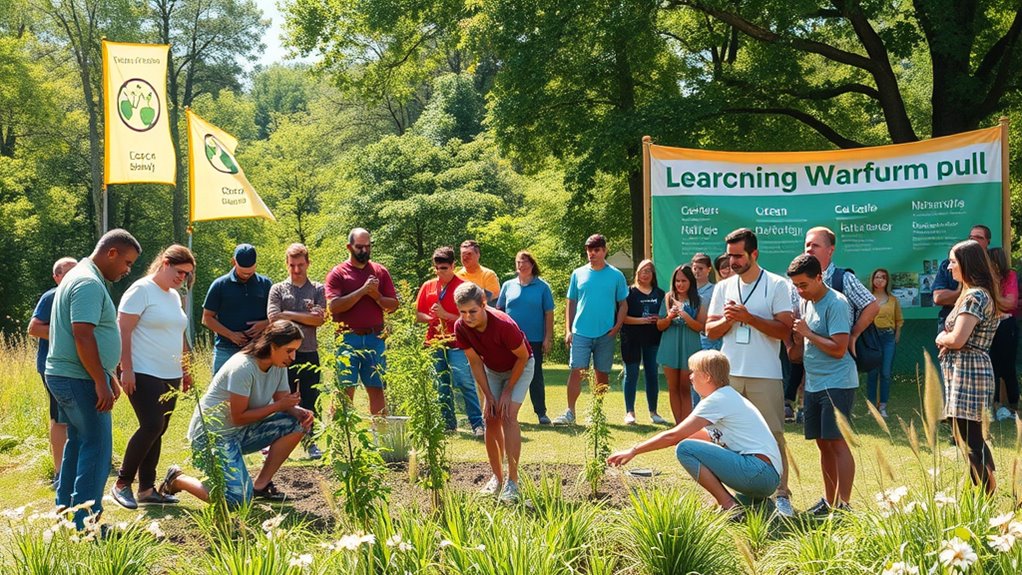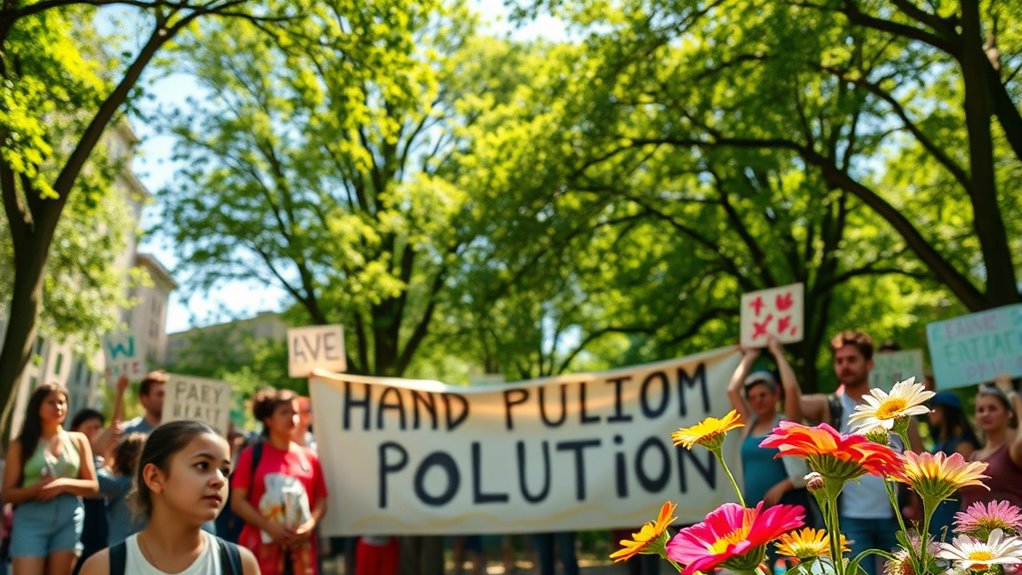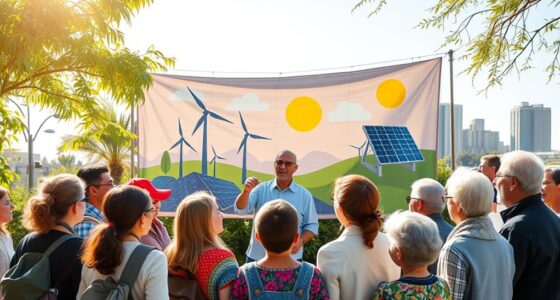You can see how communities lead change by organizing targeted efforts, like petitions, flyers, or public meetings, to shape environmental policies. Grassroots advocacy amplifies your voice, making policymakers notice and act on local concerns. Small actions build momentum, especially when combined with technology and collective support. When residents work together, they create powerful movements that influence regulations and protect natural areas. Keep exploring how grassroots efforts turn small voices into impactful environmental victories.
Key Takeaways
- Small communities can drive environmental change through organized grassroots efforts and local advocacy.
- Community engagement, like attending meetings and forming associations, amplifies collective voices for policy influence.
- Small actions such as petitions and cleanups mobilize residents and demonstrate widespread support for environmental causes.
- Organized communities leverage their collective power to influence urban planning and environmental policies.
- Technology and digital tools enhance grassroots coordination, enabling communities to effectively advocate for sustainable change.

Have you ever wondered how small communities can influence significant change? It’s a powerful question, especially when you consider the role grassroots advocacy plays in shaping our environment. Often, people underestimate the impact that local residents can have on larger issues, but through organized effort, they can drive meaningful change in urban planning and policy. When communities come together with a clear goal, their voices become a force that policymakers can’t ignore, leading to tangible improvements in their neighborhoods and beyond.
Grassroots advocacy begins with awareness. When residents recognize that urban planning decisions affect their daily lives—such as the location of parks, transportation routes, or industrial sites—they start to mobilize. By attending city council meetings, participating in public comment periods, or forming neighborhood associations, community members create a platform to voice concerns. These actions often lead to policy change, especially when they demonstrate widespread support. For example, a community might rally to prevent the construction of a polluting factory by highlighting health risks and environmental impacts, urging local governments to reconsider zoning laws or environmental regulations. This process underscores how grassroots efforts directly influence urban planning, guaranteeing it aligns with community needs and priorities.
Your involvement doesn’t need to be grand or complicated. Small actions—like distributing flyers, organizing petitions, or hosting neighborhood cleanups—can amplify the community’s message. When enough people participate, it sends a clear signal to policymakers that change is necessary. This collective pressure can lead to revisions in urban planning strategies that favor sustainability and environmental preservation. Over time, these grassroots movements can shift policy frameworks to be more inclusive and environmentally conscious, fostering a culture where community input shapes development projects from the ground up. Recognizing the importance of local engagement can further enhance these efforts by empowering residents with the knowledge and tools they need to be effective advocates. Additionally, leveraging digital tools can help organize and amplify grassroots campaigns more efficiently.
Moreover, grassroots advocacy helps bridge the gap between residents and decision-makers. It’s about turning individual concerns into a cohesive movement that makes policymakers listen. When communities demonstrate that they’re organized and committed, they gain leverage to push for policy change—whether that’s implementing green infrastructure, protecting natural areas, or improving public transportation. This bottom-up approach ensures that urban planning isn’t just dictated by developers or politicians but is reflective of the actual needs and values of those living in the community. Recognizing how community organizing can mobilize collective action is essential for effective advocacy. Furthermore, understanding the role of public participation in decision-making processes ensures that community voices are not only heard but actively influence outcomes.
In essence, grassroots advocacy harnesses the collective power of local residents to influence urban planning and policy change. It’s a reminder that real change often starts small, with dedicated individuals working together toward a common goal. When communities stand united, they can reshape their environment and create a more sustainable, equitable future for everyone. Additionally, the integration of AI security technologies can support these efforts by providing real-time data and insights that help communities better advocate for their needs and protect their environment from potential threats.
Frequently Asked Questions
How Can New Volunteers Get Involved in Grassroots Environmental Efforts?
You can get involved in grassroots environmental efforts by starting with community outreach. Attend local meetings, join cleanup events, or participate in educational workshops to understand the issues. Volunteer recruitment is often ongoing, so reach out to organizations or sign up online. Your active participation helps raise awareness and strengthens community action, making a real difference. By taking these steps, you’ll become an essential part of the movement to protect the environment.
What Funding Sources Support Grassroots Environmental Campaigns?
Did you know that nearly 60% of grassroots campaigns rely on diverse funding sources? When seeking support, look into grant opportunities from local governments, foundations, and community organizations. Funding diversity is key to sustaining your efforts, so explore various avenues like crowdfunding, donations, and partnerships. Securing a mix of grants and other resources strengthens your campaign and keeps it resilient, helping you make a lasting environmental impact.
How Do Grassroots Groups Measure Their Success?
When you want to measure your grassroots group’s success, focus on policy impact and community engagement. You can track changes in local or national policies influenced by your efforts and assess how actively your community participates in campaigns. Additionally, gather feedback, monitor increased awareness, and document tangible outcomes like new regulations or protected areas. These indicators show how effectively you’re driving change and rallying your community around common environmental goals.
What Legal Challenges Do Community-Led Environmental Initiatives Face?
Did you know that over 60% of community-led environmental initiatives face legal challenges? You might encounter policy hurdles that slow down your efforts or lack of legal protections that leave you vulnerable to opposition. Managing these obstacles requires understanding local laws and advocating for stronger legal safeguards. Staying informed and building alliances help you overcome legal challenges, ensuring your community’s voice remains strong in environmental battles.
How Can Technology Enhance Grassroots Environmental Advocacy?
Technology can markedly boost your grassroots environmental advocacy by enhancing community engagement through digital tools. You can use social media to spread awareness, organize virtual meetings, and mobilize supporters quickly. Platforms like data-sharing apps help gather and present evidence, strengthening your case. By leveraging these digital tools, you’ll make your efforts more effective, reach broader audiences, and foster stronger community involvement in environmental battles.
Conclusion
Your voice is the seed, and together, your community’s efforts are the water that nurtures change. Every small act, like planting a single sprout, grows into a powerful forest of environmental victories. When you stand united, you become the mighty oak, resilient and unstoppable. Remember, your passion is the sunlight that fuels progress. Keep advocating—because in your hands, the future of our planet takes root and blooms into hope.










